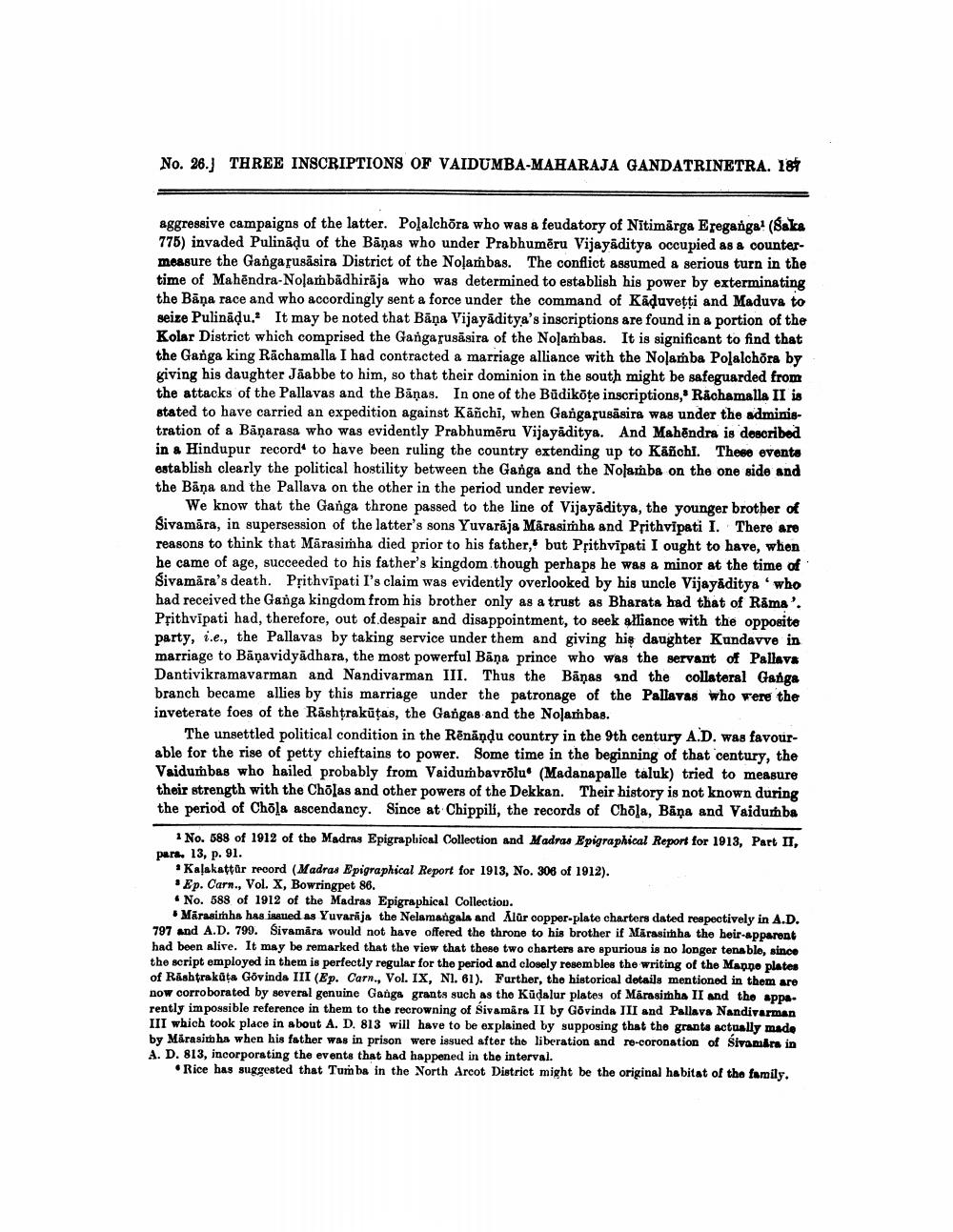________________
No. 26. THREE INSCRIPTIONS OF VAIDUMBA-MAHARAJA GANDATRINETRA. 186
aggressive campaigns of the latter. Polalchõra who was a feudatory of Nītimärga Ereganga? (Saks 775) invaded Pulinādu of the Bāņas who under Prabhumēru Vijayāditya occupied as a countermeasure the Gangarusāsira District of the Nolambas. The conflict assumed a serious turn in the time of Mahendra-Nolambādhirāja who was determined to establish his power by exterminating the Bāna race and who accordingly sent a force under the command of Kāduvetti and Maduva to seize Pulinādu. It may be noted that Bāņa Vijayāditya's inscriptions are found in a portion of the Kolar District which comprised the Gangarusāsira of the Nolambas. It is significant to find that the Ganga king Rachamalla I had contracted a marriage alliance with the Nolamba Polalchõra by kiving his daughter Jāabbe to him, so that their dominion in the south might be safeguarded from the attacks of the Pallavas and the Banas. In one of the Budikote inscriptions," Rachamalla II is stated to have carried an expedition against Kāñchi, when Gangapusāsira was under the administration of a Banarasa who was evidently Prabhumēru Vijayāditya. And Mahēndra is described in a Hindupur record to have been ruling the country extending up to Kāñchi. These evento establish clearly the political hostility between the Ganga and the Nolamba on the one side and the Bana and the Pallava on the other in the period under review.
We know that the Ganga throne passed to the line of Vijayaditya, the younger brother of Sivamāra, in supersession of the latter's sons Yuvarāja Mārasimha and Prithvipati I. There are reasons to think that Mārasimha died prior to his father, but Prithvipati I ought to have, when he came of age, succeeded to his father's kingdom though perhaps he was a minor at the time of Sivamāra's death. Prithvipati l's claim was evidently overlooked by his uncle Vijayaditya 'who had received the Ganga kingdom from his brother only as a trust as Bharata had that of Rāma'. Prithvipati had, therefore, out of despair and disappointment, to seek alliance with the opposite party, i.e., the Pallavas by taking service under them and giving hiç daughter Kundavve in marriage to Bāņavidyadhara, the most powerful Bāņa prince who was the servant of Pallava Dantivikramavarman and Nandivarman III. Thus the Bānas end the collateral Gange branch became allies by this marriage under the patronage of the Pallavas who rere the inveterate foes of the Rashtrakūtas, the Gangas and the Nolambas.
The unsettled political condition in the Rēnāņdu country in the 9th century A.D. was favourable for the rise of petty chieftains to power. Some time in the beginning of that century, the Vaidumbas who hailed probably from Vaidumbavrõlu (Madanapalle taluk) tried to measure their strength with the Cholas and other powers of the Dekkan. Their history is not known during the period of Chõla ascendancy. Since at Chippili, the records of Chõla, Bāņa and Vaidumba
No. 588 of 1912 of the Madrs Epigraphical Collection and Madras Epigraphical Report for 1913, Part II, para. 13, p. 91.
Kalakatfär record (Madras Epigraphical Report for 1913, No. 308 of 1912). • Ep. Carn., Vol. X, Bowringpet 86. • No. 588 of 1912 of the Madras Epigraphical Collection.
. Mārasimha has issued as Yuvarāja the Nelamangala and Alur oopper-plate charters dated respectively in A.D. 797 and A.D. 799. Sivamāra would not have offered the throne to his brother if Marasimha the heir-apparent had been alive. It may be remarked that the view that these two charters are spurious is no longer tenable, since the script employed in them is perfectly regular for the period and closely resembles the writing of the Mappe plates of Rashtrakūta Govinda III (Ep. Carn., Vol. IX, Ni. 61). Further, the historical details mentioned in them are now corroborated by several genuine Gangs grants such as the Kudalur plates of Márasimba II and the apparently impossible reference in them to the recrowning of Sivamara II by Govinda III and Pallava Nandiverman III which took place in about A. D. 813 will have to be explained by supposing that the grants actually made by Marasimha when his father was in prison were issued after the liberation and re-coronation of Sivamira in A. D. 813, incorporating the events that had happened in the interval.
.Rice has suggested that Tumba in the North Arcot District might be the original habitat of the family.




